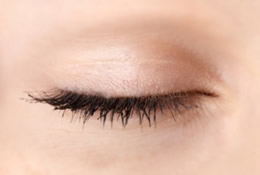Eyelid Surgery (Blepharoplasty)
 Several factors such as aging, sun damage, smoking, stretching and obesity can cause the eyelids to droop and sag as the supporting tissues deteriorate. This area is often one of the first to deteriorate, as the skin of the eyelid is thinner than the rest of the face. Eyelids that droop or bulge can cause people to appear much older or fatigued than they actually are.
Several factors such as aging, sun damage, smoking, stretching and obesity can cause the eyelids to droop and sag as the supporting tissues deteriorate. This area is often one of the first to deteriorate, as the skin of the eyelid is thinner than the rest of the face. Eyelids that droop or bulge can cause people to appear much older or fatigued than they actually are.
Blepharoplasty, also known as eyelid surgery, is a surgical procedure that improves the appearance of the upper and lower eyelids by tightening muscles and tissue or removing excess fat and skin. This procedure can be performed on men and women alike and offers a younger, more refreshed look that reflects across the whole face.
Blepharoplasty is now the most popular facial plastic surgery procedure after rhinoplasty. The popularity of this procedure reflects the importance of the eyes in perfecting overall appearance. In fact, two-thirds of adults consider the eyes to be the defining feature of the face. If you are unhappy with the appearance of your eyes, you may want to consider blepharoplasty to improve your look and boost your confidence through a safe procedure with minimal downtime.
Procedure
The blepharoplasty procedure is performed under local anesthesia with sedation. General anesthesia may be used for anxious or nervous patients. Patients may choose to have this procedure on their upper or lower eyelids, or both.
If the upper eyelid is being treated, an incision is made along the natural crease of the eyelid. Once the incision is made, your doctor may reposition fat deposits, tighten muscles and tissue or remove excess skin in order to leave the eye looking younger and refreshed. For the lower eyelid, an incision is made just below the lash line in order for excess skin to be removed. After the procedure is performed, the incisions are closed with sutures.
Recovery
After the blepharoplasty procedure, your doctor may recommend applying lubricating ointment and cold compresses to aid the healing process and minimize side effects such as swelling, bruising, irritation or dry eyes.
Patients can usually return to work within two days, but should avoid exercise and strenuous activities for at least two weeks. Your doctor will give you specific instructions on how to care for your eyes are surgery.
FREQUENTLY ASKED QUESTIONS ABOUT BLEPHROPLASTY
What can eyelid surgery do for me?
Blepharoplasty is ideal for the correction of:
» Loose, sagging and/or folded upper eyelids that may limit vision
» Puffy fat deposits in the upper eyelids
» Under-eye bags
» Sagging lower eyelids that may show the white of the eyes below the iris
» Excess skin in the lower eyelids
» Fine wrinkles in the lower eyelids
What won't blepharoplasty correct?
Blepharoplasty cannot raise the eyebrows or reduce the appearance of deep wrinkles, crow's feet or dark circles under the eyes. However, eyelid lifts can be combined with other procedures such as brow lifts, BOTOX® Cosmetic treatments and laser procedures to achieve these results.
Am I a good candidate for an eyelid lift?
The best candidates for blepharoplasty:
» Are generally healthy
» Do not smoke
» Have realistic expectations
» Do not have any serious eye conditions
Your doctor will talk to you about whether you are a good candidate for eyelid surgery.
Those interested in Eyelid surgery should find a plastic surgeon they can trust. From the initial consultation through post-surgical recovery, Dr. Lalla emphasizes an honest doctor-patient relationship that allows his patients to remain well informed of their surgical options.
| Click here for procedure animations |
To learn more about the benefits of Eyelid surgery and schedule a consultation please contact us today : (609)584-8898




